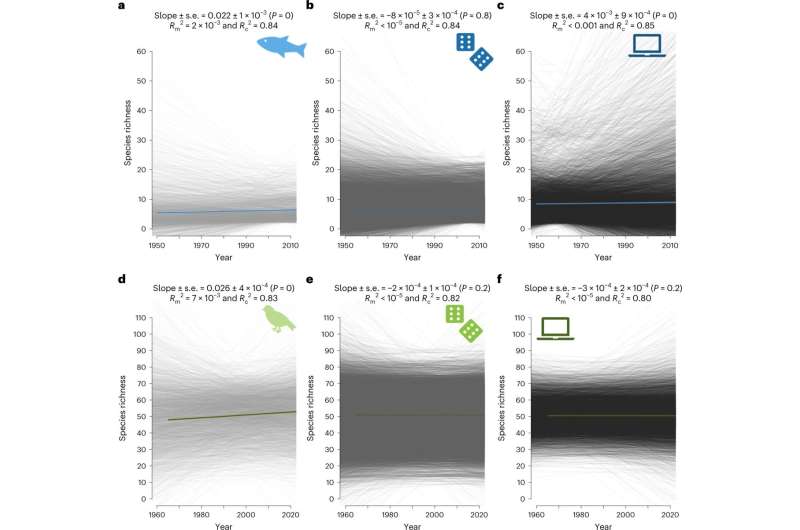This article has been reviewed according to Science X's editorial process and policies. Editors have highlighted the following attributes while ensuring the content's credibility:
fact-checked
peer-reviewed publication
proofread
Local loss of species may often be underestimated, shows new study

Seemingly healthy ecosystems with a constant or even increasing number of species may already be on the path to decline and loss of species. Even in long-term datasets, such negative trends may only become apparent with a delay. This is due to systematic distortions in temporal trends for species numbers, as a recent study which has now been published in the journal Nature Ecology & Evolution shows.
"Our results are important in order to understand that the species number alone is not a reliable measure of how stable the biological balance in a given ecosystem is at the local level," explains Dr. Lucie Kuczynski, an ecologist at the University of Oldenburg's Institute for Chemistry and Biology of the Marine Environment (ICBM) and the lead author of the study, in which she and her colleagues combined observational data for freshwater fish and birds with calculations based on simulations.
The research team, the other members of which were Professor Dr. Helmut Hillebrand from the ICBM and Dr. Vicente Ontiveros from the University of Girona in Spain, was surprised by the results: "We find it very worrying that a constant or even increasing species number does not necessarily mean that all is well in an ecosystem and that the number of species will remain constant in the long term," Hillebrand explains.
"Apparently, we have so far underestimated the negative trends for freshwater fish, for example. Species are disappearing faster than expected at the local level," adds Kuczynski.
Up to now, biodiversity research had worked on the assumption that the number of species in an ecosystem will remain constant in the long term if the environmental conditions neither deteriorate nor improve. "The hypothesis is that there is a dynamic equilibrium between colonizations and local extinctions," lead author Kuczynski explains. Increasing or decreasing species numbers are interpreted as a response to improving or deteriorating environmental conditions.
To find out whether a constant species richness is a reliable indicator of a stable biological balance, Kuczynski and her colleagues first analyzed several thousand datasets documenting the number of species of freshwater fish and breeding birds in different regions of Europe and North America over many years—24 years on average for the fish and 37 for the birds—with the aim of identifying trends in individual communities.
They then compared the empirical data with various simulation models based on different expectations regarding immigrations and extinctions of species.
The team initially observed a general increase in the number of species in both fish and bird populations during the observation periods. However, a comparison with the simulations showed that this increase was smaller than would have been expected. The researchers attributed this discrepancy to an imbalance between colonizations and local extinctions: "According to our simulations organisms such as freshwater fish which have limited potential for dispersal colonize an ecosystem faster than in neutral models, while their extinction occurs later than expected," says Kuczynski.
This means that after an environmental change, species that are in fact doomed to extinction may remain present in an ecosystem for some time, while at the same time new species also move in. This effect disguises the impending loss of biodiversity, she explains. "There are transitional phases in ecosystems in which the number of species is higher than expected. Species extinction occurs only after these transition phases—and then usually faster than expected."
The team anticipates that a reassessment of which methods are best suited for monitoring the state of ecosystems will now be necessary, and that nature conservation targets—which in most cases aim to preserve existing species diversity—may also need to be redefined. The model developed by Kuczynski and her colleagues could serve as a tool to distinguish between the different mechanisms that influence species richness, and also provides information on the extent to which the observational data deviates from expected changes.
More information: Lucie Kuczynski et al, Biodiversity time series are biased towards increasing species richness in changing environments, Nature Ecology & Evolution (2023). DOI: 10.1038/s41559-023-02078-w
Journal information: Nature Ecology & Evolution
Provided by Carl von Ossietzky-Universität Oldenburg



















